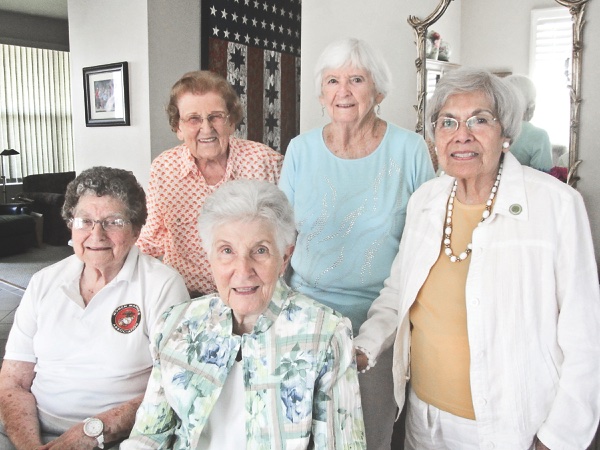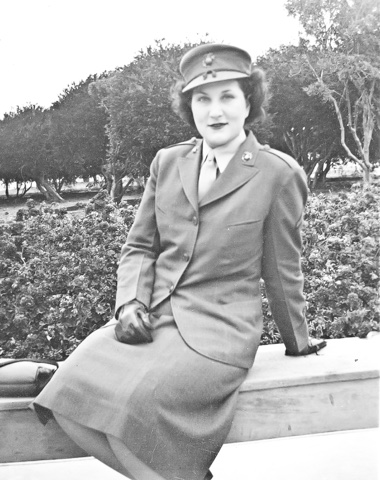The Women Marines, that is. On Saturday, Ann DiValerio, of Sun City Huntley, hosted a picnic for the Women Marines Association of Illinois. The group is dedicated to preserving the heritage of the Women Marines. The WMA also provides a forum for them to “pass the torch” to the new generation of Marines.
In attendance were four Women Marines who served during WWII. In their 90s now, the women are still vibrant and proud of their service.
“Everyone was very patriotic back then”, said Ann who’s fiancé was a Marine killed during the battle for Tarawa.

Seated, left to right: Helen Laukes, who served in the motor pool at Camp LeJeune; Ann DiValerio, who was a Librarian at Marine Recruit Depot San Diego, then served in the Quartemaster Office at Bremerton, WA. (Standing, left to right:) Helen Ehlers, who served at the Air Base Cherry Point; Gwen DePinto, who was stationed at Marine Headquarters Washington D.C.; Mary Roa, who served during the Korean Conflict. (Photos provided)
Helen Laukes, past president of the Women Marines National Organization, said “We didn’t think twice, you just did what had to be done”.
The roll call is shorter now, Taps having been played for many of the women who served during WWII, but the dedication and resolve of those who remain is always strong.
Their stories are full of adventure and character, and they tell them with pride, but the Women Marines insist “it was nothing special”. Some joined because loved ones were in the service, others joined because they had a special skill to invest. No matter what the reason, they all joined to “Free a Marine to fight.” They were called “Lady Leathernecks”.

On February 13, 1943, General Thomas Holcumb (the wartime Commandant of the Marine Corps) approved the formation of the Women Marine Corps Reserves (WMCR). The mission of the WMCR was to provide women who were trained and qualified in non-combat duties, thereby releasing male Marines for combat. From the beginning, the Women Marines were treated much as the men Marines were. They had rigorous enlistment qualifications and went to Boot Camp at Camp LeJeune. They wore the same uniforms (though cut for a woman). There were inspections and close-order drills, they slept in barracks, and ate in mess halls. They even had their own band.
A total of 19,000 women took the oath of Marine “for the duration and 6 months”. These all-American women trained for jobs in the motor pool, repairing aircraft engines, training Marine pilots on the “Link Trainer,” packing parachutes, and ferrying planes. The Women Marines were trained and worked at 125 jobs at 52 Marine posts and stations. Their entrance into the war effort freed enough combat Marines to put the 6th Marine Division into the field for the Pacific Drive at Okinawa.
General Alexander Vandegrift remarked, “You have developed an Esprit de Corps worthy of admiration of the most tough-going veteran in our ranks.”
The Women Marines visiting Ann today served in various capacities and had different experiences during the war, but one thing brings them together: the honor and valor that makes a Marine.




